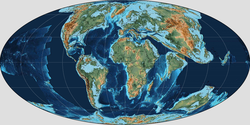Río Loro Formation
The Río Loro Formation is a geological formation of the Sierras Pampeanas in Tucumán Province Argentina whose strata date back to the Late Paleocene of the Paleogene, or Riochican in the SALMA classification.
| Río Loro Formation Stratigraphic range: Late Paleocene (Riochican) ~58–56 Ma | |
|---|---|
| Type | Geological formation |
| Underlies | Río Nío Formation |
| Overlies | Los Blanquitos Formation |
| Thickness | 95 m (312 ft) |
| Lithology | |
| Primary | Sandstone, siltstone |
| Other | Conglomerate, paleosols |
| Location | |
| Coordinates | 26.6°S 65.2°W |
| Approximate paleocoordinates | 29.3°S 53.8°W |
| Region | Tucumán Province |
| Country | |
| Extent | Sierras Pampeanas |
| Type section | |
| Named for | Río Loro |
| Named by | Bossi |
| Year defined | 1969 |
 Río Loro Formation (Argentina) | |
The formation has been deposited in a meandering fluvial environment and has a maximum noted thickness of 95 metres (312 ft).
The formation has provided fossils of several mammals and reptiles. The crocodylian genus Lorosuchus and mammal species Eoastrapostylops riolorense were named after the formation which is correlated with the Mealla Formation of the Salta Basin to the northwest of Tucumán Province.
Description

The Río Loro Formation crops out in the Sierra Medina, north of Tucumán city. The formation, first defined by Bossi in 1969,[1] reaches a thickness of 95 metres (312 ft),[2] and comprises red sandstones and siltstones deposited in a fluvial meandering environment.
The Río Loro Formation unconformably overlies the Cretaceous Los Blanquitos Formation and is overlain by the Río Nío Formation. The Río Loro Formation is correlated with the Mealla Formation of the Salta Basin to the northeast.[2]
Fossil content
The following fossils were reported from the formation:[3]
- Mammals
- Notoungulates
- Satshatemnus bonapartei[4]
- Eutheria
- Notonychops powelli[4]
- Xenungulata
- Rodcania kakan[5]
- Placentalia
- Eoastrapostylops riolorense[6]
- Notoungulates
- Reptiles
- Turtles
- Podocnemis cf. argentinensis[7]
- Crocodylians
- Turtles
References
- Babot et al., 2017, p.732
- Georgieff, 2014, p.6
- Río Loro Formation at Fossilworks.org
- Soria, 1989
- Gelfo et al., 2020
- Soria & Powell, 1981
- De Broin & De la Fuente, 1993
Bibliography
- Gelfo, J.N.; D.A. García López, and L.P. Bergqvist. 2020. Phylogenetic relationships and palaeobiology of a new xenungulate (Mammalia: Eutheria) from the Palaeogene of Argentina. Journal of Systematic Palaeontology _. 1.
- Babot, J., et al. 2017. Mamíferos paleógenos del subtrópico de Argentina: síntesis de estudios estratigráficos, cronológicos y taxonómicos, 730-753. XX Congreso Geológico Argentino. Accessed 2020-06-14. ISBN 978-987-42-6666-8
- Georgieff, Sergio M. 2014. Paleógeno y Neógeno de Tucumán: estratigrafía y paleoambientes sedimentarios, 106-123. Geología de Tucumán. Accessed 2020-06-14.
- Pol, Diego, and Jaime E. Powell. 2011. A new sebecid mesoeucrocodylian from the Rio Loro Formation (Palaeocene) of north-western Argentina. Zoological Journal of the Linnean Society 163. S7–S36. Accessed 2020-06-14.
- De Broin, F., and M. de la Fuente. 1993. Les tortues fossiles d'Argentine: synthese - The fossil turtles of Argentina: synthesis. Annales de Paléontologie (Invertebrés-Vertebrés) 79. 169-232.
- Soria, M.F. 1989. El primer Notoungulata de la Formación Rio Loro (Paleoceno medio), Provincia de Tucumán, Republica Argentina. Ameghiniana 26. 145-151.
- Soria, M.F., and J.E. Powell. 1981. Un primitivo Astrapotheria (Mammalia) y la edad de la Formación Río Loro, provincia de Tucumán, República Argentina. Ameghiniana 18. 155-168.